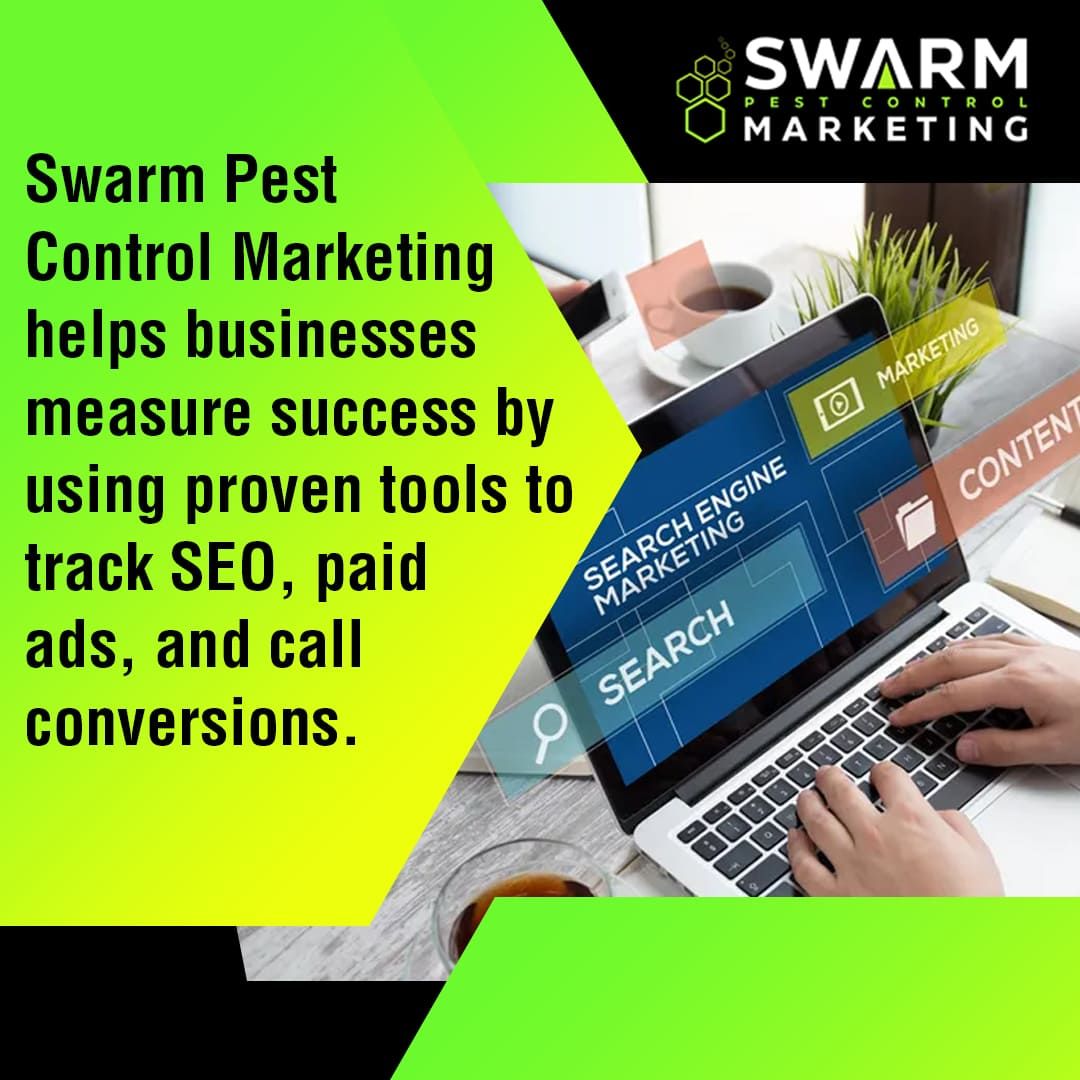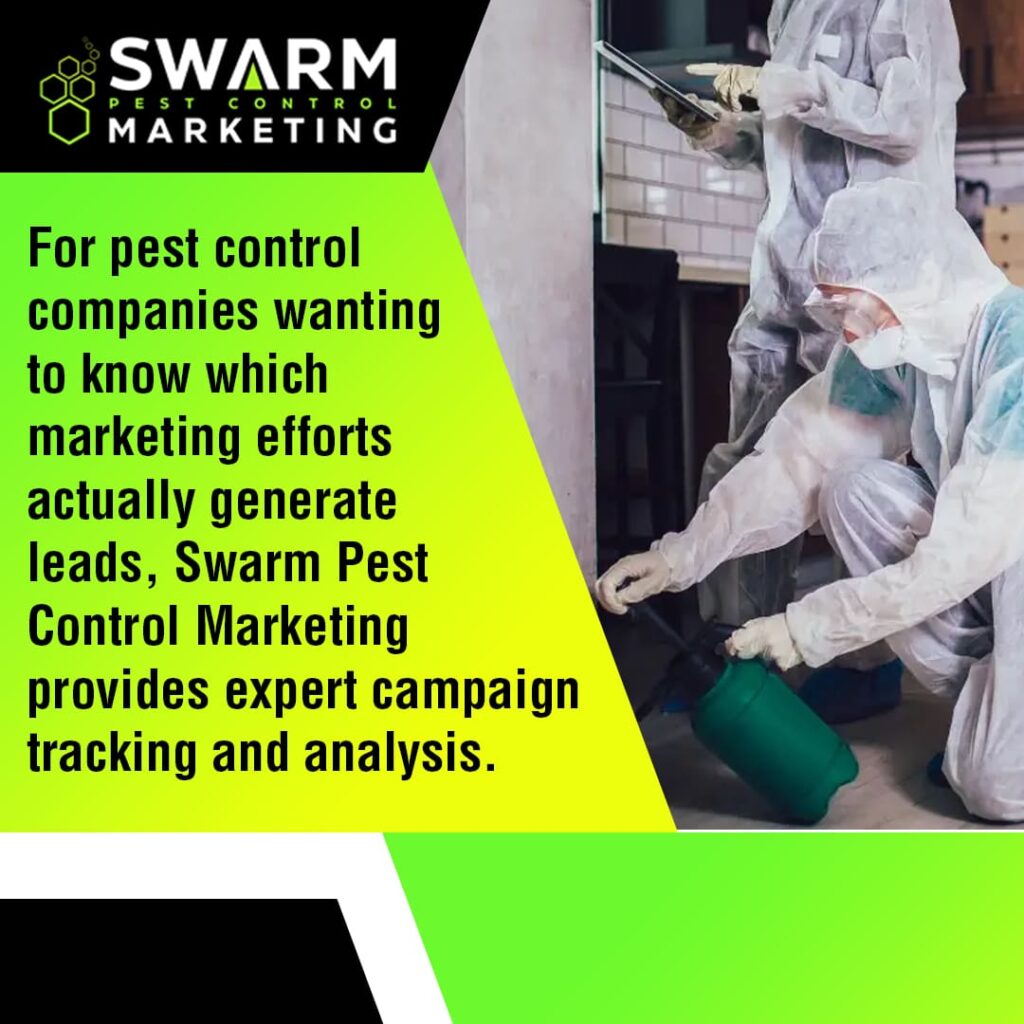
Swarm Pest Control Marketing: How to Track and Measure Your Pest Control Campaigns for Better Results
Swarm Pest Control Marketing, based in Tucson, Arizona, specializes in delivering targeted pest control digital marketing solutions that help businesses track and improve their campaign performance. Understanding how your marketing efforts translate into leads and sales is essential for growth. Whether you use web design for pest control, paid ads, or organic SEO, measuring the success of each campaign guides better decision-making and maximizes return on investment.
Tracking pest control marketing campaigns requires clear goals and reliable tools to capture relevant data. From analyzing website traffic to monitoring social media engagement and paid advertising results, each channel offers valuable insights. Here, we’ll explain how to effectively track your pest control marketing campaigns and why accurate measurement matters for sustainable business growth.
Why Tracking Your Pest Control Marketing Campaign Matters
Tracking your pest control digital marketing campaign helps you identify which actions generate leads and revenue. This knowledge allows you to allocate your budget wisely and avoid spending on ineffective tactics.
Benefits of Monitoring Campaign Results
Tracking campaigns reveals what delivers leads and revenue. Monitoring helps pest control companies see which pest control marketing ideas bring customers. This insight allows better budget allocation and avoids wasting resources on ineffective tactics.
For instance, you might find that Google Ads bring more qualified leads, while some Facebook ads have a lower return. Tracking lets you compare these outcomes and shift resources to higher-performing channels within your digital marketing efforts.

Key Metrics to Watch
Important metrics include leads, traffic, conversion rate, and cost per lead.
- Leads refer to potential customers who express interest.
- Traffic is the number of visitors your website attracts through marketing for pest control.
- Conversion rate measures the percentage of visitors who become customers.
- Cost per lead shows how much you spend to acquire one lead.
Knowing these metrics helps you evaluate each campaign’s success. For example, if your cost per lead is too high, it might be time to adjust your ads or enhance your SEO strategies.
Setting Up Tracking Systems
Tracking systems are the foundation for measuring the success of your pest control digital marketing efforts. Proper setup lets you collect accurate data to understand which marketing channels work best for your business.
Choosing Tracking Tools
Use tools like Google Analytics and call tracking software. Google Analytics monitors visitor behavior on your website, providing insight into traffic sources and user actions. Call tracking software assigns phone calls to specific campaigns, giving a full picture of your marketing for pest control performance.
Together, these tools allow you to evaluate both online engagement and direct phone inquiries. For example, Google Analytics can show how many users visit your site after clicking a social media ad, while call tracking reveals which ads generate calls.
Adding Tracking Codes and Pixels
Insert tracking codes and pixels on your website and landing pages. These snippets collect data about visitors’ interactions, helping you analyze campaign results accurately.
For instance, a Facebook pixel tracks users who come from Facebook ads, showing which pest control marketing ideas attract the most attention. Adding pixels to landing pages created through your web design for pest control strategy helps measure conversions directly related to your ads.
Phone Call Tracking Basics
Assign unique phone numbers to campaigns for accurate call tracking. This process connects incoming calls to specific marketing efforts, clarifying which ads or channels produce the best results.
Using different phone numbers for Google Ads, social media, and direct mail lets you see exactly where calls originate. This insight helps improve your digital marketing focus and increase lead generation efficiency.
Measuring Different Marketing Channels
Tracking the performance of each marketing channel gives you insight into what’s working and where to focus your efforts. Understanding how SEO, paid ads, social media, and your website perform individually helps you manage your pest control digital marketing effectively.
SEO Tracking
Monitor organic search traffic and keyword rankings. SEO performance is measured by the number of visitors arriving from search engines and how well your site ranks for important keywords such as “pest control services.” Higher rankings increase visibility, which can drive more leads without additional ad spend.
Tracking SEO success also includes monitoring changes in rankings over time and the quality of traffic coming from organic search. This data helps refine your marketing for pest control strategies and optimize your website content for better search engine results.
Paid Ads Tracking
Track clicks, impressions, and conversion rates on paid ads. These metrics indicate how effectively your paid campaigns attract potential customers and encourage them to take action. For example, if a Google Ads campaign targeting local pest control services generates many clicks but few conversions, the ad or landing page might need adjustment.
Evaluating the cost per conversion helps you manage your budget and get the best results from paid advertising. This process is essential when developing pest control marketing ideas that maximize your advertising spend.
Social Media Tracking
Measure engagement, follower growth, and referral traffic from social platforms. Social media success is reflected in likes, shares, comments, and how many visitors come to your website through these channels. These indicators show how well your content connects with your audience.
Tracking social media allows you to see which posts generate the most interest and which platforms bring the most traffic, supporting better planning for digital marketing campaigns and web design for pest control that encourages interaction.
Website Performance
Evaluate bounce rate, page views, and session duration. These data points show how visitors interact with your website. A high bounce rate might suggest that your site or landing page is not meeting visitor expectations or needs improvement.
By understanding these metrics, you can make adjustments to your site’s design, navigation, or content to keep visitors engaged longer. Improving website performance is a critical part of pest control digital marketing as it directly influences conversion rates.
Using Tracking Data to Improve Campaigns
Tracking data helps you understand how your pest control digital marketing efforts are performing over time. By analyzing this information, you can make targeted changes that increase efficiency and generate more leads.
Spotting Trends
Identify which campaigns consistently bring results. Tracking data reveals ongoing patterns that highlight your most effective ads and marketing channels. For instance, you might notice that certain Google Ads campaigns steadily bring in more inquiries than others. Similarly, your web design for pest control may influence how long visitors stay on your site, indicating user engagement.
These trends help you recognize what aspects of your marketing for pest control strategy attract and retain customers. Monitoring this over weeks or months allows you to predict which campaigns will continue to perform well so that you can plan accordingly.
Making Budget Adjustments
Shift budget toward high-performing marketing efforts. If a specific channel does not generate expected results, reallocating your marketing budget can improve overall returns. For example, if paid social media ads underperform but SEO efforts bring steady organic traffic, it makes sense to invest more in SEO.
Balancing your spending across different channels based on real data is vital to avoid wasting resources. Using tracking tools helps you decide where to scale up or pull back your investment, which is a key part of managing digital marketing for pest control companies.
Refining Messaging
Use data feedback to test and improve ad content. Analyzing which ads and messages lead to the highest conversions allows you to adjust your communication style, offers, and calls to action. For example, if ads highlighting eco-friendly pest control services get more clicks, you can emphasize that message in future campaigns.
This testing and refining process can be applied across multiple platforms, from Google Ads to social media. It complements your broader pest control marketing ideas by aligning your messaging with customer preferences, increasing engagement and response rates.

Common Tracking Challenges
Tracking marketing results can reveal valuable insights, but certain obstacles often affect data accuracy and interpretation. Being aware of these challenges helps maintain reliable reporting for your pest control digital marketing efforts.
Data Gaps
Some data may be missing due to user settings or technical issues. For example, many users block cookies or use privacy settings that prevent tracking tools from collecting full data. This limits how accurately you can measure website traffic or ad performance.
These data gaps can affect the quality of reports from tools like Google Analytics or call tracking software. Understanding these limitations is important when analyzing your marketing for pest control and adjusting strategies accordingly.
Attribution Issues
Determining which channel deserves credit can be complex. Customers often engage with several touchpoints before deciding to use a pest control service. For instance, a lead might initially find your company through SEO, then click on a paid ad, and finally call after seeing a social media post.
This multi-step process complicates assigning conversions to a single source. Using models like multi-touch attribution helps provide a clearer picture, but requires careful setup within your digital marketing systems.
Consistency Over Time
Tracking tools and settings need regular maintenance. Updates to your website, changes in monitoring pixels, or platform adjustments can disrupt data collection if not managed properly. Regularly reviewing and updating your tracking setup prevents loss of important information.
Consistent monitoring and maintenance support accurate data collection, which is key to evaluating your pest control marketing ideas and improving your overall web design for pest control efforts.
How Swarm Pest Control Marketing Supports You
Swarm Pest Control Marketing provides specialized support to help you track and improve your pest control digital marketing campaigns. Our services focus on delivering clear insights and practical guidance tailored to your business.
Customized Tracking Solutions
Swarm Pest Control Marketing tailors tracking to your pest control business needs. We design monitoring systems that align with your marketing for pest control objectives, whether you focus on SEO, paid ads, or social media. By customizing tools like Google Analytics and call tracking software, we capture the data that matters most to your campaigns.
This approach makes sure that your web design for pest control includes integrated tracking features, allowing seamless measurement of visitor actions and lead sources.
Reporting and Analysis
Receive clear, actionable reports to understand performance. We provide detailed reports that summarize key metrics such as lead counts, traffic sources, conversion rates, and cost per lead. Our analysis explains what the numbers mean and offers suggestions based on data.
These insights help you evaluate different pest control marketing ideas and determine which channels deliver the best results for your investment.
Ongoing Campaign Support
Swarm Pest Control Marketing monitors campaigns continuously and advises on adjustments. Marketing efforts require regular attention to respond to changes in customer behavior and platform updates. Our team watches your campaign data closely and recommends shifts in strategy or budget allocation when needed.
This ongoing support helps you maintain effective digital marketing and maximizes returns on your marketing budget.
Ready to Elevate Your Pest Control Marketing?
Partner with Swarm Pest Control Marketing to track and boost your campaign performance with professional support tailored to your business. Contact us today at (866) 466-8570 to start optimizing your pest control digital marketing efforts.
marketing for pest control, pest control marketing ideas, SEO